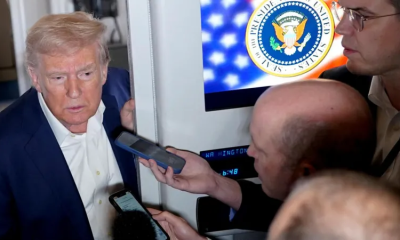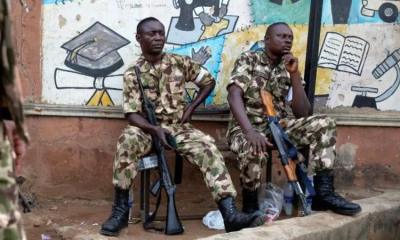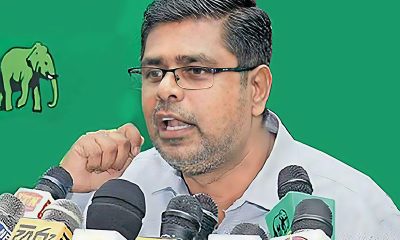Sports
Asitha rips through Bangladesh as Sri Lanka win Test series
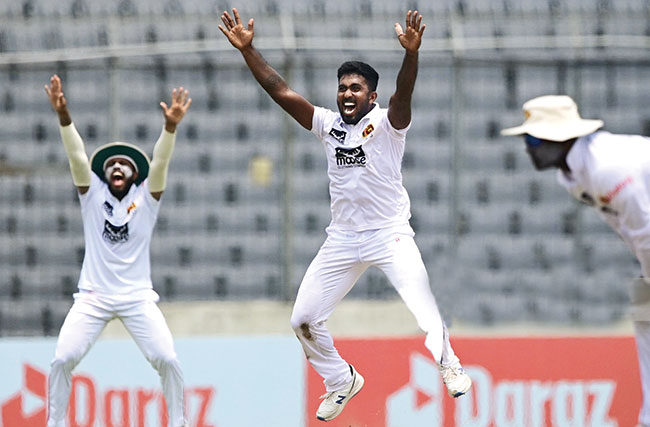
Asitha Fernando finished with a career-best six for 51 as Sri Lanka thrashed hosts Bangladesh by ten wickets in the second Test yesterday to win the two match series 1-0.The visitors bowled out Bangladesh for 169 runs in their second innings with 24-year-old Asitha playing a starring role at the National Cricket Stadium in Dhaka.
“We knew we needed a couple of wickets to go our way,” said Sri Lanka skipper Dimuth Karunaratne.
“The fast bowlers did the job for us, both in the first innings as well as the second.”
Sri Lanka made 506 runs in the first innings after bowling out Bangladesh for 365.
Oshada Fernando sealed the devastating win with an unbeaten 21 in three overs.Play had resumed on the fifth and final day with the hosts at a precarious 34-4 and Sri Lanka upped the pressure when Kasun Rajitha bowled Mushfiqur Rahim for 23 in the eighth over.Shakib Al Hasan and Liton Das both hit fifties in a 110-run stand and held on through the first session with a mix of caution and aggression.
Shakib’s counter-attack saw him hit Rajitha for three fours in one over, forcing Sri Lanka to widen their field set-up, while Liton played an anchor role after resuming on one overnight.Liton was given out caught behind off Rajitha on nine as he attempted to flick a ball going down the leg, but survived on review.It was the fourth caught behind decision overturned in the match, all given by West Indies umpire Joel Wilson.
A counter-punching Shakib brought his 27th Test fifty in the last ball before lunch with a boundary off Dhananjaya de Silva, before Asitha drove the hosts’ collapse after lunch.He took the scalps of both Liton and Shakib soon after the break, claiming four of the last five wickets after dispatching openers Mahmudul Hasan Joy and Tamim Iqbal the previous day.Ramesh Mendis trapped Mosaddek Hossain for nine before Asitha wrapped up the Bangladesh innings with the wickets of Taijul Islam and Khaled Ahmed in successive deliveries.
“A disappointing performance,” said Bangladesh captain Mominul Haque.
“They put us under pressure with the new ball, we’ll have to handle it better next time,” he added.
Asitha conceded 144 runs for his first 10-wicket Test match haul, with 4-93 in the first innings.He and Rajitha had Bangladesh reduced to a pitiful 24 for five at the start of the first day before Mushfiqur (175 not out) and Das (141) staged a recovery.But Sri Lanka rode on man of the series Angelo Mathews (145 not out) and Dinesh Chandimal’s 124 to take a commanding 141-run first-innings lead.
Bangladesh collapsed again at the start of their second innings, losing the first four wickets for 23 runs to leave Sri Lanka in full control.The first Test in Chittagong ended in a draw.Bangladesh will now tour West Indies for two Tests, three Twenty20 internationals and three one-day internationals starting in June.Sri Lanka host Australia next month — despite anxieties about the island nation’s protracted economic crisis — for three T20Is, five ODIs and two Tests.
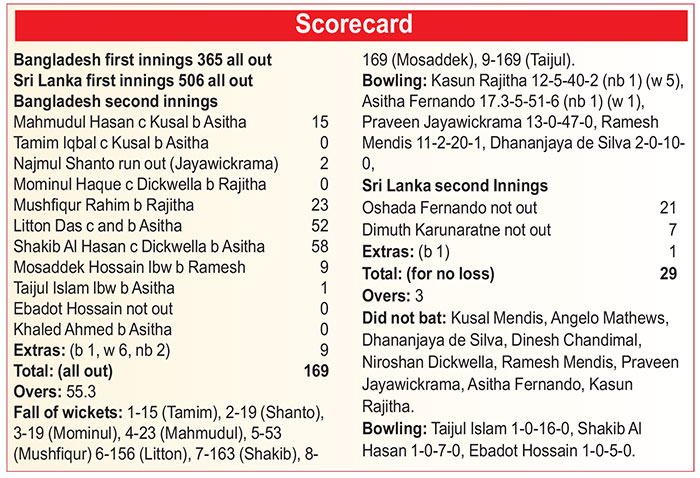
Sports
Lankan legends, Modi and the Jaffna dream
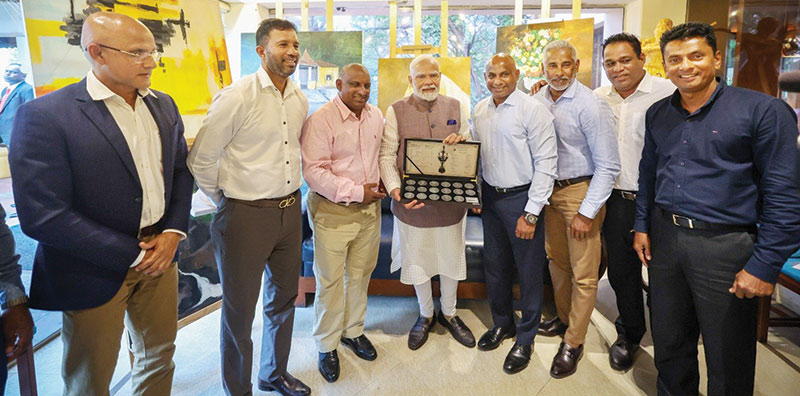
Tamil Members of Parliament with roots across the Palk Strait are often quick to look towards India at the drop of a hat. But last week, all they managed was a photo op with Indian Prime Minister Narendra Modi – smiles, handshakes and little else. In contrast, Sri Lanka’s 1996 World Cup-winning cricket team was granted a 45-minute chinwag over tea with the Indian leader. The Indian High Commission in Colombo had arranged the meeting. Not even former President Ranil Wickremesinghe, with all his so-called diplomatic finesse, has managed to get a similar audience.
Pictures of Modi rubbing shoulders with Sanath Jayasuriya and Aravinda de Silva went viral in India on social media and it was the talking point across news channels and print media as well. And why not? Not since the marauding days of Sir Vivian Richards have Indian bowlers been sent on a leather hunt quite like they were by these two Sri Lankan giants. It was déjà vu for Indian fans – memories of the Wills World Cup semi-final at Eden Gardens, still fresh like an old wound that refuses to heal.
During the meeting, Jayasuriya pitched an idea to the Indian PM – seeking help to build a cricket stadium in Jaffna. It wasn’t a doosra out of nowhere. There’s a deep and genuine passion for cricket in the north. Some of the school big matches in the region have stood the test of time, with legacies stretching back over a century. Yet, due to decades of conflict, the region has remained a barren patch in terms of producing top-tier cricketing talent.
Since the guns fell silent, though, there’s been a fresh crop of hopefuls from the north. Leading the charge is leg-spinner Vijayakanth Viyaskanth – a name that’s now turning heads. Though his First-Class stats are more than decent, Viyaskanth has chosen the glitz and glamour of franchise cricket, where the pay cheques are fatter and the schedule less grueling.
Behind the scenes, Sri Lanka Cricket’s (SLC) District and Provincial coaches have done a stellar job, scouting and grooming pace bowlers and other youngsters from these long-neglected areas. Some of these boys have gone on to wear the Under-19 jersey with pride – a sign that the talent pool is slowly, but surely, filling up.
However, SLC’s grand vision of building new stadiums to attract larger crowds has hit a few bumps. The old guard – some former greats – have been quick to swing the bat in criticism. They’ve taken their eye off the ball, failing to see the bigger picture. Take next year’s T20 World Cup, for instance. Co-hosted by Sri Lanka and India, it promises to be a blockbuster. The high-voltage India – Pakistan clash is set to take place in Colombo, with the R. Premadasa Stadium’s 35,000 seats expected to vanish like isso vade at the Galle Face green. A bigger venue – like the proposed facility in Homagama – would have been just the ticket to meet such mammoth demand.
But Sanath’s plea is in a different league altogether. He’s not asking for a behemoth like Eden Gardens or the Narendra Modi Stadium in Ahmedabad. His is a humble request – a ground with decent infrastructure and floodlights that can host day-night matches. A facility like that would be a game-changer for the north, a true shot in the arm. Nothing ignites a young cricketer’s imagination more than watching their heroes up close, not through a television screen but under the stars, in their own backyard.
At present, the closest international venue to Jaffna is in Dambulla—hardly accessible, especially for aspiring fans and players from the peninsula. A ground in Jaffna would not only bridge that distance but also build a bridge of hope and opportunity.
Back in 2002, when Janashakthi opened a branch in Jaffna, the great Muttiah Muralitharan made the long road trip to play a friendly match on a matting wicket. The welcome he received was nothing short of electric. The crowd adored him, showering him with affection that could rival the warmth of any southern stand.
Since then, we’ve hardly scratched the surface when it comes to understanding the region’s cricketing appetite. If the Indian government lends an ear to Sanath’s appeal, we might just discover a goldmine of talent waiting to be unearthed in the north. Who knows? The next Murali or Malinga might be bowling on a dusty street in Jaffna this very moment – waiting for a stage, a spotlight, and a bit of help from across the Palk Strait.
by Rex Clementine
Sports
Sri Sumangala’s cricketing miracle
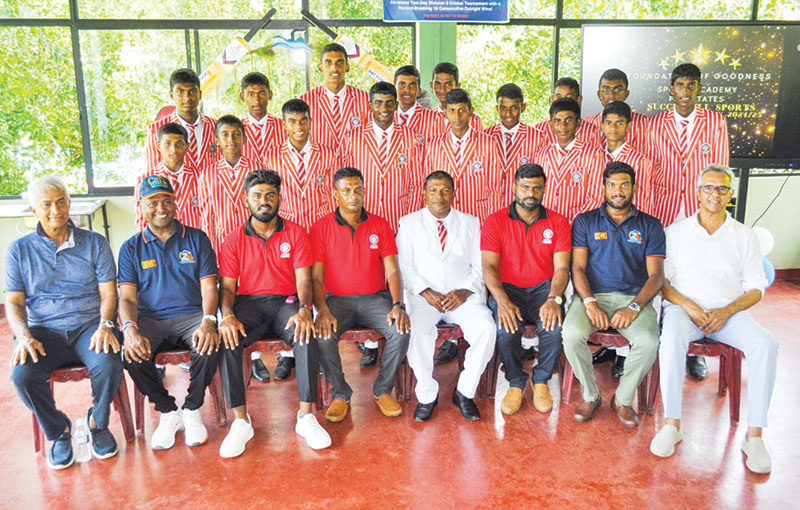
Sri Sumangala Vidyalaya, Hikkaduwa has scripted a fairytale rise in school cricket, marking a monumental milestone just 18 years after forming its first team. Once deprived of even a proper ground, the school now proudly boasts an unbeaten Under-19 team that has clinched both the Division III two-day and one-day championships — a rare double that has earned them promotion to Division 2.
The turnaround began in 2007 when the Marylebone Cricket Club (MCC) helped establish the Sri Sumangala MCC Lord’s Cricket Grounds following the devastating tsunami. This facility, offered free of charge, became a beacon for young cricketers who had talent but lacked opportunity. What followed is nothing short of a sporting miracle: 16 consecutive outright wins by the U19 team and national recognition in school cricket circuits.
This isn’t just a story of trophies and titles — it’s about breaking generational barriers. These young cricketers, once trapped in a cycle of poverty and obscurity, now inspire their community and set benchmarks for others in rural Sri Lanka.
The MCC’s early investment has borne fruit, turning dreams into tangible success. Today, the legacy of Lord’s lives not only in London but also in the hearts of the aspiring cricketers of Hikkaduwa — proof that when given a chance, talent can indeed take flight.
Foundation of Goodness has been a beacon of hope for sporting talents in the region and representation for Sri Lanka Women’s Under-19 team has been dominated by them. The same could happen with the men’s team in the near future.
Sports
St. Sebastian’s back on the basketball track
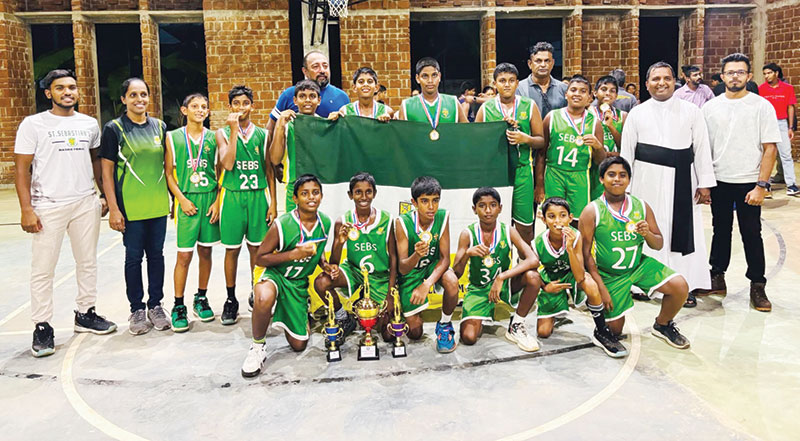
In the bygone years it was the Colombo schools that dominated basketball in Sri Lanka. Bens under Ram Sunderalingam, Peterites coached by Naufer Mahroof and the Josephians shaped by Mahadevan were the trojans who won tournaments. Led by this trio and flanked by other basketball playing schools in the capital, the game had its foundation laid down in concrete – Colombo style.
Moratuwa and Batticaloa were the painful thorns amidst the Colombo teams when it came to championships. And Trinco was the dark horse, almost unbeatable in their heyday, playing under the wizard, late Father Eugene Herbert. This is what basketball was, beginning from the sixties.
Today the faded memories remain. On a lucky day one might meet Doc Thurai, as he was popularly known, walking his wards with the stethoscope round his neck. He was the best we saw in that era. If one visits Batticaloa there is a prominent statue outside the town. It is of a tall Jesuit Priest. Here, he cradles a Wilson basketball ready to take a ‘time-out’ and yell at the referee. That is Father Herbert, the man who filled the Eastern Province with stellar players who left their luminous mark in the basketball courts of Sri Lanka.
More recently in April, on the 6th Sunday, I watched the under 13 ‘B’ division basketball finals between St. Sebastian’s and St. Thomas’ Prep. It was played at a flood-lit indoor court in Moratuwa. No, it certainly wasn’t in the league of Madison Square Garden, but it was more than adequate for a schools’ final. I sat on a wooden bench and watched the match thanking the court creator Sugath Thevarapperuma. I must mention this former national player who is doing yeomen service to promote basketball by establishing indoor courts in different locations.
Back to the match. It was good and exciting and the Sebastians won 37-36 by a solitary point. This was great for Moratuwa and the school and the young players. This victory would awaken the school and the basketballers from the doldrums they had been mired for a considerable time to say ;we are coming back’.
This 1-point victory I witnessed appeared to me as a catalyst for greater performances and perhaps an eye-opener for the Moratuwa lads. They are indeed capable of leaping bigger steps to reach higher pedestals in schools’ basketball championships. Yes, that is an achievable possibility, and the need is to change gears and go for the over-drive.
It is time for St Sebastian’s to forget the apathetic era and the reasons for such, and forge ahead with renewed motivation to re-claim former glories with their current potential.
The Thomians fought to the end. They certainly were equal in spirit and determination to become the champions. The difference was simply 1 solitary point. The pattern of play was the same by both teams and the award for the best player went to Akash Wijesinghe and Amantha Hettiarachchi was adjudged the best guard.
I noticed that some new rules have been introduced to control the game. The teams are only allowed to play ‘man-to-man’ and they could do so only from the center line. Additionally, the coach cannot use a double guard on the opposing best player. The teams are not allowed to use a zonal defense or play a floating man to man. If these rules came from FIBA then there is no argument. But if it is a local ramification of rules of how the game should be played, I have to humbly say that this will be a significant deterrent to coaches and players and a recurring headache to the referees. Over to you Sir, the Head of the Schools’ Basketball Association.
For me personally, it was an ‘Alma Mater delight’ to notice that the two coaches of the playing teams were both from St Sebastians and the assistant coach too was from my old school. Chaminda de Alwis and Susil Dias coached St. Sebastian’s and Isuru Perera the Thomians.
Chaminda captained the national team and Isuru had Ceylon Basketball colours and Susil represented All Island Schools.
Yes, St. Sebastian’s had a lot of glory days in basketball. Many of their players represented and captained the national team. Then one might ask, “how come they hit rock bottom playing a game they more or less dominated?”
The answer is simple, I will leave it for another day to elaborate.
On second thoughts, some things are best left unsaid.
by Capt. Elmo Jayawardena
elmojay1@gmail.com
-

 Business6 days ago
Business6 days agoColombo Coffee wins coveted management awards
-

 News1 day ago
News1 day agoSuspect injured in police shooting hospitalised
-

 Features2 days ago
Features2 days agoRobbers and Wreckers
-

 Features4 days ago
Features4 days agoSri Lanka’s Foreign Policy amid Geopolitical Transformations: 1990-2024 – Part III
-

 Midweek Review4 days ago
Midweek Review4 days agoInequality is killing the Middle Class
-

 Features6 days ago
Features6 days agoSri Lanka’s Foreign Policy amid Geopolitical Transformations: 1990-2024 – Part I
-

 Business1 day ago
Business1 day agoSanjiv Hulugalle appointed CEO and General Manager of Cinnamon Life at City of Dreams Sri Lanka
-

 Features5 days ago
Features5 days agoA brighter future …



